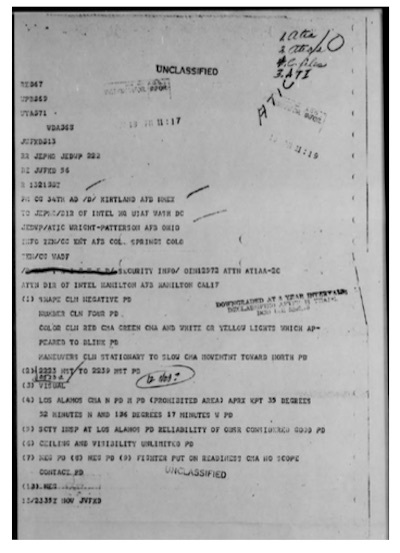The 701 Club: Case 2219 November 12, 1952 Los Alamos, NM
Don Berlinner lists the case as follows:
Nov. 12, 1952; Los Alamos, New Mexico. 10:23 p.m. Witness: security inspector. Four red-white-green lights flew slowly over a prohib- ited area for 15 minutes.1
Sparks’ entry mentions that it could not be a balloon or a plane but, other than that, adds little else.2
The Blue Book file
The file is pretty barren. Besides the record, which states the winds were generally in the east direction and no aircraft were al- lowed over the prohibited area, it consists of a simple message that does not indicate direction of observation or elevation of the object(s). It mentions the objects were moving “slowly” north.3 The message does give the following description of the four objects:
SHAPE CLN NEGATIVE PD
NUMBER CLN FOUR PD
COLOR CLN RED CMA GREEN CMA AND WHITE OR YELLOW LIGHTS WHICH APPEARED TO BLINK PD MANEUVERS CLN STATIONARY TO SLOW CMA MOVEMTMT (sic) TOWARD NORTH PD
This means there were four points of light that were stationary sometimes and showed some slow northward motion. These points of light flashed different colors. They were visible for 15 minutes. We don’t know if they disappeared or if the observer simply stopped watching them and went about their business.

Analysis
With so little information, I could simply reclassify this as insufficient information but I always want to see if there is a potential explanation. I think the description given in the message matches the kinds of descriptions I have seen of scintillating stars. The diurnal motion of the stars rising could result in the belief in motion of the lights moving northward. While most stars have a westward component to their motion, They also increase in angle of elevation above the horizon. Any such elevation increase could be misperceived as moving northward.
We don’t know the location of the observer or the exact direction they were looking. However, based on the information available, we can assume the observer was at the approximate location listed. This is two miles east of the main facility. All of the prohibited areas were to the east, south, and west of him.
That brings me to consider the possibility that he was looking east/southeast and saw the bright winter stars rising. Both Sirius and Procyon were in the southeast. Due east were the stars Castor and Pollux. Additionally, the bright stars in Orion were towards the southeast but higher. Towards the southwest was the first magnitude star Fomalhaut. All would scintillate enough to give the

A photograph showing some of the bright winter stars visible in the evening sky. While this was taken in January, the same stars would have been visible in the southeastern sky in November.
appearance of blinking various colors. All but Fomalhaut would have an increase in elevation with time, which could be mistaken for slow movement towards the north.
It is important to point out that this security inspector was the only person, who saw these objects even though they were visible for at least fifteen minutes. None of the security patrols or security posts made any reports and radar reported no contacts. This makes one conclude that what was seen was not that prominent or unusual.
Conclusion
In my opinion, this case should be reclassified as “insufficient information” since there is little data to make any analysis. It is also my opinion that the observer possibly misperceived scintillating stars. If this is correct, two of the UFOs were probably Sirius and Procyon. One can take their pick of other first magnitude stars in the sky as the other two objects. Whether it is classified as “insuffi- cient information” or “possible stars”, this case should be removed from the list of unidentifieds.
Quelle: SUNlite 6/2018
